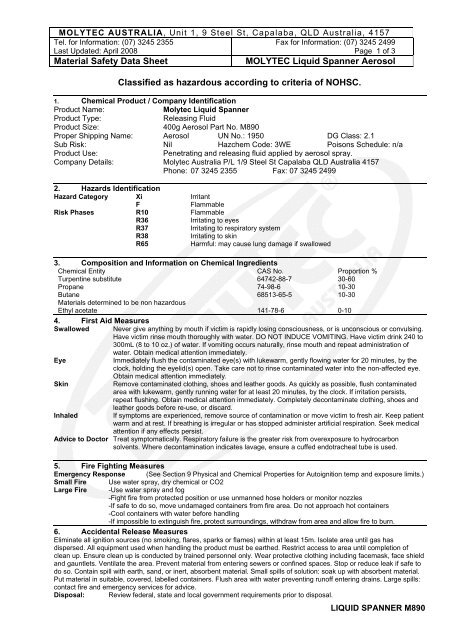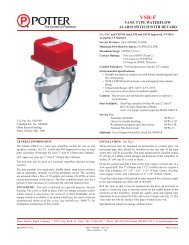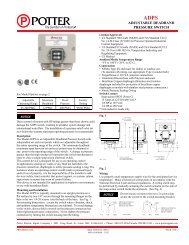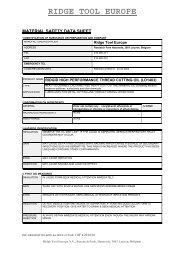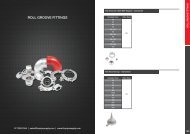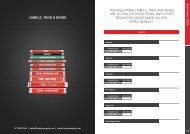Please refer to website - Firepipe Supply
Please refer to website - Firepipe Supply
Please refer to website - Firepipe Supply
You also want an ePaper? Increase the reach of your titles
YUMPU automatically turns print PDFs into web optimized ePapers that Google loves.
MOLYTEC AUSTRALIA, Unit 1, 9 Steel St, Capalaba, QLD Australia, 4157<br />
Tel. for Information: (07) 3245 2355<br />
Fax for Information: (07) 3245 2499<br />
Last Updated: April 2008<br />
Page 1 of 3<br />
Material Safety Data Sheet<br />
MOLYTEC Liquid Spanner Aerosol<br />
Classified as hazardous according <strong>to</strong> criteria of NOHSC.<br />
1. Chemical Product / Company Identification<br />
Product Name:<br />
Molytec Liquid Spanner<br />
Product Type:<br />
Releasing Fluid<br />
Product Size:<br />
400g Aerosol Part No. M890<br />
Proper Shipping Name: Aerosol UN No.: 1950 DG Class: 2.1<br />
Sub Risk: Nil Hazchem Code: 3WE Poisons Schedule: n/a<br />
Product Use:<br />
Penetrating and releasing fluid applied by aerosol spray.<br />
Company Details: Molytec Australia P/L 1/9 Steel St Capalaba QLD Australia 4157<br />
Phone: 07 3245 2355 Fax: 07 3245 2499<br />
2. Hazards Identification<br />
Hazard Category Xi Irritant<br />
F<br />
Flammable<br />
Risk Phases R10 Flammable<br />
R36<br />
Irritating <strong>to</strong> eyes<br />
R37<br />
Irritating <strong>to</strong> respira<strong>to</strong>ry system<br />
R38<br />
Irritating <strong>to</strong> skin<br />
R65<br />
Harmful: may cause lung damage if swallowed<br />
3. Composition and Information on Chemical Ingredients<br />
Chemical Entity CAS No. Proportion %<br />
Turpentine substitute 64742-88-7 30-60<br />
Propane 74-98-6 10-30<br />
Butane 68513-65-5 10-30<br />
Materials determined <strong>to</strong> be non hazardous<br />
Ethyl acetate 141-78-6 0-10<br />
4. First Aid Measures<br />
Swallowed Never give anything by mouth if victim is rapidly losing consciousness, or is unconscious or convulsing.<br />
Have victim rinse mouth thoroughly with water. DO NOT INDUCE VOMITING. Have victim drink 240 <strong>to</strong><br />
300mL (8 <strong>to</strong> 10 oz.) of water. If vomiting occurs naturally, rinse mouth and repeat administration of<br />
water. Obtain medical attention immediately.<br />
Eye<br />
Immediately flush the contaminated eye(s) with lukewarm, gently flowing water for 20 minutes, by the<br />
clock, holding the eyelid(s) open. Take care not <strong>to</strong> rinse contaminated water in<strong>to</strong> the non-affected eye.<br />
Obtain medical attention immediately.<br />
Skin<br />
Remove contaminated clothing, shoes and leather goods. As quickly as possible, flush contaminated<br />
area with lukewarm, gently running water for at least 20 minutes, by the clock. If irritation persists,<br />
repeat flushing. Obtain medical attention immediately. Completely decontaminate clothing, shoes and<br />
Inhaled<br />
leather goods before re-use, or discard.<br />
If symp<strong>to</strong>ms are experienced, remove source of contamination or move victim <strong>to</strong> fresh air. Keep patient<br />
warm and at rest. If breathing is irregular or has s<strong>to</strong>pped administer artificial respiration. Seek medical<br />
attention if any effects persist.<br />
Advice <strong>to</strong> Doc<strong>to</strong>r Treat symp<strong>to</strong>matically. Respira<strong>to</strong>ry failure is the greater risk from overexposure <strong>to</strong> hydrocarbon<br />
solvents. Where decontamination indicates lavage, ensure a cuffed endotracheal tube is used.<br />
5. Fire Fighting Measures<br />
Emergency Response (See Section 9 Physical and Chemical Properties for Au<strong>to</strong>ignition temp and exposure limits.)<br />
Small Fire Use water spray, dry chemical or CO2<br />
Large Fire -Use water spray and fog<br />
-Fight fire from protected position or use unmanned hose holders or moni<strong>to</strong>r nozzles<br />
-If safe <strong>to</strong> do so, move undamaged containers from fire area. Do not approach hot containers<br />
-Cool containers with water before handling<br />
-If impossible <strong>to</strong> extinguish fire, protect surroundings, withdraw from area and allow fire <strong>to</strong> burn.<br />
6. Accidental Release Measures<br />
Eliminate all ignition sources (no smoking, flares, sparks or flames) within at least 15m. Isolate area until gas has<br />
dispersed. All equipment used when handling the product must be earthed. Restrict access <strong>to</strong> area until completion of<br />
clean up. Ensure clean up is conducted by trained personnel only. Wear protective clothing including facemask, face shield<br />
and gauntlets. Ventilate the area. Prevent material from entering sewers or confined spaces. S<strong>to</strong>p or reduce leak if safe <strong>to</strong><br />
do so. Contain spill with earth, sand, or inert, absorbent material. Small spills of solution: soak up with absorbent material.<br />
Put material in suitable, covered, labelled containers. Flush area with water preventing runoff entering drains. Large spills:<br />
contact fire and emergency services for advice.<br />
Disposal: Review federal, state and local government requirements prior <strong>to</strong> disposal.<br />
LIQUID SPANNER M890
MOLYTEC AUSTRALIA, Unit 1, 9 Steel St, Capalaba, QLD Australia, 4157<br />
Tel. for Information: (07) 3245 2355<br />
Fax for Information: (07) 3245 2499<br />
Last Updated: April 2008<br />
Page 2 of 3<br />
Material Safety Data Sheet<br />
MOLYTEC Liquid Spanner Aerosol<br />
7. Safe Handling Information<br />
S<strong>to</strong>rage:<br />
-S<strong>to</strong>re in original containers in approved flameproof area<br />
-DO NOT s<strong>to</strong>re in pits, depressions, basements or areas where vapours may be trapped.<br />
-No smoking, naked lights, heat or ignition sources.<br />
-Keep containers securely sealed. Contents under pressure.<br />
-S<strong>to</strong>re away from incompatible materials.<br />
-S<strong>to</strong>re in a cool, dry, well ventilated area in an upright position out of direct sunlight.<br />
-Avoid s<strong>to</strong>rage at temperatures higher than 40°C<br />
-Protect containers against physical damage and check regularly for leaks.<br />
8. Exposure Control and Personal Protection<br />
Exposure Limits No exposure standards have been established for this material. Exposure standards<br />
recommended by NOHSC for some ingredients are as follows:<br />
Name STEL TWA<br />
Propane<br />
Asphyxiant<br />
Butane<br />
800ppm<br />
Turpentine substitute 790mg/m³<br />
Ethyl Acetate 1400mg/m³ 400ppm<br />
Engineering Controls Use in well ventilated areas. Ensure ventilation is adequate <strong>to</strong> maintain air concentrations<br />
below Exposure Standards. Use with local flameproof exhaust ventilation or while wearing<br />
organic vapour respira<strong>to</strong>r. Vapour is heavier than air – prevent concentrations in hollows or<br />
sumps. DO NOT enter confined spaces where vapour may have collected. Explosive gas<br />
atmospheres may form, for further information <strong>refer</strong> <strong>to</strong> AS 2430.<br />
Personal Protection Where ventilation is not adequate, respira<strong>to</strong>ry protection may be required. An approved organic<br />
Respira<strong>to</strong>r Type vapour respira<strong>to</strong>r should be used. Respira<strong>to</strong>ry protection should comply with AS/NZS 1715 and<br />
AS/NZS 1716<br />
Eye Protection<br />
Safety glasses or chemical goggles. Failure <strong>to</strong> do so may result in eye damage if an accident<br />
occurs. Consult AS 1336 & AS/NZ 1337 for information about eye protection.<br />
Glove Type<br />
Available information suggests gloves made of nitriles, vi<strong>to</strong>n, neoprene or other similar solvent<br />
resistant material. Keep solvent contact <strong>to</strong> a minimum. For help in selecting suitable gloves<br />
consult AS2161<br />
Clothing<br />
Overalls or similar protective clothing. Consult AS 2919 for advice.<br />
Always wash hands before smoking, eating, drinking, or using the <strong>to</strong>ilet. Wash contaminated<br />
clothing and other protective equipment before s<strong>to</strong>ring or re-using.<br />
Flammability<br />
-Heat or damage <strong>to</strong> containers may release flammable gases<br />
Fire Hazards<br />
-Containers will explode when heated – ruptured containers will rocket<br />
-Released gases may form explosive mixtures with air in confined spaces<br />
-Released gases may travel <strong>to</strong> source of ignition and flash back<br />
-Organic chemicals may form flammable dust clouds in air; will burn if involved in fire<br />
-Fire may produce irritating, poisonous and/or corrosive gases.<br />
9. Physical and Chemical Properties<br />
Appearance & Odour:<br />
Clear brown liquid<br />
Boiling Point:<br />
between 77° <strong>to</strong> 195°C (for liquid concentrate)<br />
Specific Gravity:<br />
0.78 (for liquid concentrate)<br />
Solubility in Water:<br />
Soluble (for liquid concentrate)<br />
Vapour Pressure:<br />
400Kpa @ 25°C (propane/butane blend propellant)<br />
Flash Point:<br />
-17°C (propane/butane blend propellant)<br />
Flamm. Limits:<br />
1.5% <strong>to</strong> 9.6% in air (v/v)(propane/butane blend propellant)<br />
Au<strong>to</strong>ignition temp:<br />
494°C <strong>to</strong> 600°C (propane/butane blend propellant)<br />
PH:<br />
Not Available<br />
Percent volatiles: approximately 70%<br />
10. Stability and Reactivity<br />
-Vapour is highly flammable<br />
-Severe fire hazard when exposed <strong>to</strong> heat or flame<br />
-Vapour forms explosive mixture with air<br />
-Vapour may travel considerable distance <strong>to</strong> source of ignition<br />
-Heating may cause expansion with violent container rupture<br />
-Aerosol cans may explode on exposure <strong>to</strong> naked flames<br />
-Rupturing containers may rocket and scatter burning materials<br />
-Hazards may not be restricted <strong>to</strong> pressure effects<br />
-Organic chemicals may form flammable dust clouds in air; will burn if involved in fire<br />
-May emit acrid, poisonous or corrosive fumes<br />
-On combustion, may emit <strong>to</strong>xic fumes of carbon monoxide (CO)<br />
-Other combustion products include carbon dioxide (CO2)<br />
Conditions <strong>to</strong> avoid: See “Safe Handling Information” (Section 7).<br />
LIQUID SPANNER M890
MOLYTEC AUSTRALIA, Unit 1, 9 Steel St, Capalaba, QLD Australia, 4157<br />
Tel. for Information: (07) 3245 2355<br />
Fax for Information: (07) 3245 2499<br />
Last Updated: April 2008<br />
Page 3 of 3<br />
Material Safety Data Sheet<br />
MOLYTEC Liquid Spanner Aerosol<br />
11. Toxicological Information<br />
Health Effects<br />
Acute<br />
If swallowed will cause irritation <strong>to</strong> the mouth, throat and s<strong>to</strong>mach lining. May result in nausea,<br />
Swallowed<br />
pain and vomiting. Severe lung damage can occur if solvents are aspirated in<strong>to</strong> lungs.<br />
Eye<br />
May cause moderate eye irritation with tearing, pain, redness and possible temporary<br />
impairment of vision. Contact with liquefied gas will cause severe damage.<br />
Skin<br />
Prolonged contact with skin may have a de-fatting effect which may lead <strong>to</strong> irritation and in<br />
some cases irritant contact dermatitis. Contact with liquefied gas can result in cold contact<br />
burns.<br />
Inhaled<br />
Inhalation of solvent vapour may cause nose and throat irritation. Inhalation of solvent vapour<br />
may result in nervous system effects such as dizziness, nausea, headache and sleepiness.<br />
Overexposures are irritating <strong>to</strong> the respira<strong>to</strong>ry system. Intentional misuse by deliberately<br />
concentrating and inhaling the contents can be harmful or fatal. Intentional ‘sniffing’ or<br />
inhalation of high levels of concentrated <strong>to</strong>luene vapours can result in death from cardiac arrest<br />
due <strong>to</strong> ventricular fibrillation, particularly in the case of children or adolescents.<br />
Chronic<br />
Prolonged or repeated skin contact may lead <strong>to</strong> irritation contact dermatitis. Chronic solvent<br />
inhalation may cause kidney and liver damage and blood changes.<br />
12. Ecological Information<br />
Not Available<br />
13. Disposal Considerations<br />
Recommended method of disposal: Dispose of according <strong>to</strong> Federal, State and local government regulations.<br />
EPA hazardous waste number:<br />
Not a RCRA hazardous waste.<br />
14. Transport Information<br />
Transportation:<br />
Incompatible products:<br />
15. Regula<strong>to</strong>ry Information<br />
None Available<br />
S5<br />
UN 1950<br />
Class 2.1<br />
Flammable gases shall not be loaded in the same vehicle or packed in the same<br />
freight container with:<br />
-Class 1 explosives<br />
-Class 3 flammable liquids (where both flammable liquids and gases are in bulk)<br />
-Class 4.1 flammable solids<br />
-Class 4.2 spontaneously combustible substances<br />
-Class 4.3 dangerous when wet substances<br />
-Class 5.1 oxidising agents<br />
-Class 5.2 organic peroxides<br />
-Class 7 radioactive substances<br />
16. Other Information<br />
Users should verify the currency of this data sheet if more than 5 years old. The information contained in this material<br />
safety data sheet is believed <strong>to</strong> be accurate on the date of issue and in accordance with the information available <strong>to</strong> us.<br />
Persons dealing with products <strong>refer</strong>red <strong>to</strong> in this MSDS do so at their own risk. We accept no liability whatsoever for<br />
damage or injury however caused arising from use of this information or of suggestions contained herein.<br />
POLICE AND FIRE BRIGADE: DIAL 000<br />
For further safety information contact Denis Brown at MOLYTEC AUSTRALIA on:<br />
Tel: (07) 3245 2355 Fax: (07) 3245 2499<br />
P.O. Box 5357, Alexandra Hills, QLD, Australia, 4161<br />
Disclaimer<br />
The information contained within this MSDS applies only <strong>to</strong> the MOLYTEC product <strong>to</strong> which the sheet relates. The information provided is<br />
based on our best knowledge at the time of issue.<br />
The information contained within this MSDS is believed <strong>to</strong> be accurate and is given in good faith. However no warranty is made, either<br />
express or implied, regarding its accuracy or any liability arising out of the use of the information herein or the products supplied.<br />
When used in other preparations, formulations, or in mixtures, it is necessary <strong>to</strong> ascertain whether the classification of the hazards has<br />
changed. The attention of the user is drawn <strong>to</strong> the possibility of creating other hazards when the product is used for purposes other than<br />
that for which it was recommended. In such cases a reassessment may be necessary and should be made by the user.<br />
This safety data sheet should only be used and reproduced in order that the necessary measures are taken relating <strong>to</strong> the protection of<br />
health and safety at work.<br />
It is the responsibility of the handlers <strong>to</strong> pass on the <strong>to</strong>tality of the information contained within this document <strong>to</strong> any subsequent person(s)<br />
who will come in <strong>to</strong> contact with, handle or use this product in any way.<br />
They should check the adequacy of the information provided within this MSDS before passing it on <strong>to</strong> their cus<strong>to</strong>mers / staff.<br />
END OF DOCUMENT<br />
LIQUID SPANNER M890


